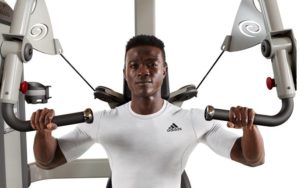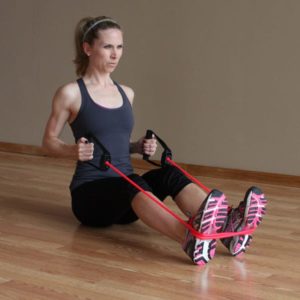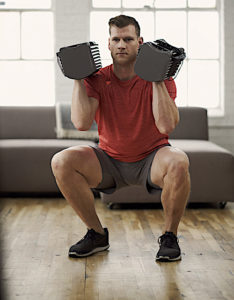Are Your Muscles Turning to Jello?
If you are a consistent exerciser or were, you are probably not performing resistance training with the same frequency or intensity. Are you losing muscle mass and power?

Concerning strength, the de-training process is different than aerobic training. That is because as you train with weights, more processes and factors contribute to strength. And they don’t decline equally when you reduce training.

If there is good news about de-training on the muscular front, it is that it takes quite a while for the muscles to really decline. In short, you can go up to 17 weeks of lessened activity, and the drop in strength and size will stabilize if you have just a little bit of maintenance. What are the changes when you don’t go to the gym and train at home?
Interestingly enough, when you decrease resistance training, one of the main decrements is the loss of muscle glycogen or the fuel you use during resistance training. When you quit training with moderate to high volume/intensity, your muscles respond by decreasing the fuel storage capacity. Another change is the reduced amount of water in the tissue. The first loss can be described as the deflation of the muscular balloon concerning glycogen and water. Hans and Frans were right, you do need to get pumped up.

Because strength and power have a neurological component (how you activate the muscle), you might guess reducing training will result in less muscle activation. The conclusion is that while you drop strength, it is not as much as you think. This is very much like the loss of aerobic fitness for high-level endurance athletes, little changes feel like a big deal. Evidence of the drop in power has been studied by the changes in the one-repetition maximum (1RM). Overall, with either significantly dropping training minutes or stopping altogether, the average person will lose 5-10% of their 1RM.

If you could bench press 280 pounds, and now it is only 250, not likely that will interfere with activities of daily living. However, if you are a senior and your 1RM leg press was 100 pounds, and now it is only 80, that will definitely impact your ability to take stairs and do such things as yard work. Like other fitness variables, it does involve where you start and your other activities during exercise in place.
Another consideration is older adults gain coordination from resistance training. These relationships and changes are present at age 40 and really accelerate after age 50. The reason is simple, more experience with how to adjust force and speed efficiently with different parts of the muscle. Sometimes non-utilized muscles reconnect, and sometimes the connection efficiency improves. The reality is older adults are more coordinated through a regular resistance program than prior. You make connections between the brain and the muscle, and then you learn how to use those connections. That is an excellent reason to keep going at home, it will transfer back to things like golf and tennis when things open up.

Knowing these metrics, what are the most practical methods to keep up your strength? First, in the world of muscle, if you can’t train as hard, train longer. The research is clear that in essential maintenance, the volume might be the most beneficial consideration. Make sure you are doing 59 minutes of resistance training twice per week. That is just not likely to happen in a 30-minute, all-in-one class. The best results will come from focusing on strength for the total training time.

Most people don’t have a vast amount of space or equipment at home for resistance training. If you are going to use dumbbells, then you really need a range of 5-50 pounds. Powerblock has nifty sets where each dumbbell fits into the set, saving space but giving lots of resistance options. Another choice at home is resistance bands. Adjustable bands, which let you add resistance by just changing the handle, are an excellent alternative to dumbbells. The same basic resistance range here is a good start, 10-50 pound bands. An adjustable bench is an excellent ancillary tool for both training modes.

While kettlebells have quite a bit of urban legend going, truth be told you can do many of the same exercises with a heavier dumbbell or band. When in doubt, basics are best. You are going to get a good deal more out of five sets of squats than five sets of kettlebell swings that have a squat component. It is about muscular work and practical multi-joint exercises. To a degree, the same thing is true with upper body exercises. Make sure you have a variety of necessary presses and pulls like chest press and a horizontal row. A great deal more benefit per minute of time than triceps kickbacks! If you keep moving, it will be relatively easy to fill 59 minutes with movements that are relevant to strength maintenance.

There is a strong relationship between both strength and coordination with eccentric or lowering abilities. You can make sure you address this component in several creative ways. First, make sure the lowering or eccentric phase of the exercise takes about one second. Another option is to take one set per exercise and lower the resistance on a two-count rather than a one-count. Not the same thing as adding resistance to the eccentric portion of the exercise, yet it does have some benefit.
So when you get back to the gym, going right back to the same training volume and intensity is going to feel a bit awkward for a week or two, maybe three. A good strategy is to go back and use slightly lighter sets and more volume for two weeks, such as four sets of 20 repetitions to prime the body into ramping up the glycogen fuel tank and water storage.
References
Brown M, Holloszy JO. Effects of walking, jogging and cycling on strength, flexibility, speed and balance in 60- to 72-year olds. Aging (Milano). 1993;5(6):427–434.
Costill DL, Fink WJ, Hargreaves M, King DS, Thomas R, Fielding R. Metabolic characteristics of skeletal muscle during detraining from competitive swimming. Med Sci Sports Exerc. 1985;17(3):339–343.
Buckner SL, Dankel SJ, Mattocks KT, et al. The problem of muscle hypertrophy: Revisited. Muscle Nerve. 2016;54(6):1012–1014.
Coratella G, Schena F. Eccentric resistance training increases and retains maximal strength, muscle endurance and hypertrophy in trained men. Applied Physiology, Nutrition, and Metabolism. 2016;41(11):1184-1189.
Delshad M, Ghanbarian A, Mehrabi Y, Sarvghadi F, Ebrahim K. Effect of Strength Training and Short-term Detraining on Muscle Mass in Women Aged Over 50 Years Old. Int J Prev Med. 2013;4(12):1386–1394.
Dudley GA, Tesch PA, Miller BJ, Buchanan P. Importance of eccentric actions in performance adaptations to resistance training. Aviat Space Environ Med. 1991;62(6):543–550.
Hwang PS, Andre TL, McKinley-Barnard SK, Morales Marroquín FE, Gann JJ, Song, Joon J,Willoughby DS. Resistance Training–Induced Elevations in Muscular Strength in Trained Men Are Maintained After 2 Weeks of Detraining and Not Differentially Affected by Whey Protein Supplementation. The Journal of Strength & Conditioning Research. 2017;31(4):869-881.
Knuiman P, Hopman MT, Mensink M. Glycogen availability and skeletal muscle adaptations with endurance and resistance exercise. Nutr Metab (Lond). 2015;12:59.
Lemmer JT, Hurlbut DE, Martel GF, Tracy BL, Ey FM, Metter E, Fozard JL, Fleg JL, Hurley BF. Age and gender responses to strength training and detraining, Medicine & Science in Sports & Exercise: 2000;32(8):1505-1512 .
Sale DG. Neural adaptation to resistance training. Med Sci Sports Exerc. 1988;20(5 Suppl):S135–S145.
Santos E, Janeira M. Effects of Reduced Training and Detraining on Upper and Lower Body Explosive Strength in Adolescent Male Basketball Players, Journal of Strength and Conditioning Research: 2009;23(6):1737-1744.
Silva NL, Oliveira RB, Fleck SJ, Leon AC, Farinatti P. Influence of strength training variables on strength gains in adults over 55 years-old: a meta-analysis of dose-response relationships. J Sci Med Sport. 2014;17(3):337–344.
Staron RS, Leonardi MJ, Karapondo DL, et al. Strength and skeletal muscle adaptations in heavy-resistance-trained women after detraining and retraining. J Appl Physiol (1985). 1991;70(2):631–640.
Taaffe DR, Marcus R. Dynamic muscle strength alterations to detraining and retraining in elderly men. Clin Physiol. 1997;17(3):311–324.

